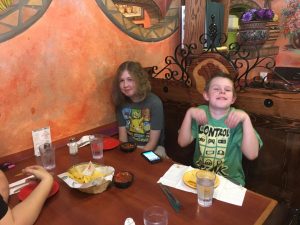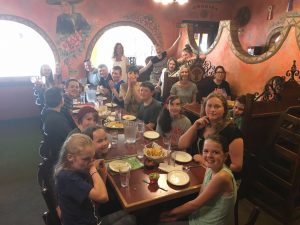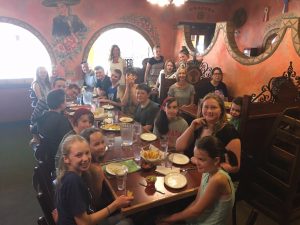El almuerzo / Lunch, plus more food practice
We practiced more food and beverage terms with indoor and outdoor games as well as learning to ask one another what we eat for lunch.
¿Qué comes para el almuerzo? (What do you eat for lunch?)
Comidas y bebidas / Food and drinks
This week we started Lección 16: learning about foods, beverages and meals. We practiced asking what we ate for breakfast (el desayuno). We will continue building on this vocabulary in the coming weeks!
So far we’ve learned about a variety of foods and drinks:
comidas / foods
la manzana = apple
el helado = ice cream
la lechuga = lettuce
la naranja = orange
el pan = bread
la mantequilla = butter
el cereal = cereal
los panqueques = pancakes
el yogur = yogurt
la fruta = fruit
el azúcar = sugar
los huevos = eggs
el huevo = egg
bebidas / drinks
la leche = milk
el café = coffee
el jugo = juice
el agua = water
We also learned about the country, culture and history of Peru in South America.
Homework due 5/23: Q4 W5 Espanol HW
Las estaciones y las fechas / The seasons and dates
This week, we learned about months, dates and seasons. Note, just like with the days of the week, in Spanish the months are not capitalized!
Los meses / months:

January = enero (ay-NAIR-oh)
February = febrero (fay-BRAIR-oh)
March = marzo (MAR-so)
April = abril (ah-breel)
May = mayo (sounds like MY-oh, not May-o)
June= junio (HOO-nee-oh)
July = julio (HOO-lee-oh)
August = agosto (ah-GOH-stoh)
September = septiembre (sep-tee-EM-bray)
October = octurbre (ohk-TU-bray)
November = noviembre (no-be-EM-bray)
December = diciembre (dee-cee-EM-bray)
Winter = el invierno (el een-bee-AIR-no)
Spring = la primavera (la pree-mah-BAIR-a)
Summer = el verano (el bair-AH-no)
Fall= el otoño (el oh-TOH-nyo)
Practice using this online game: http://www.digitaldialects.com/Spanish/Daysmonths.htm
La hora – Telling the time
Telling the time in Spanish can be a challenge, since the conventions of “a quarter past,” “half past”, “mid-day” and “twenty to – ” are used, rather than speaking in digital terms such as 10:22, 11:45, etc.
El reloj = the clock
How do we ask and answer questions about the time?
For the question, use ES. For the answer, use SON (except for “una” or 1 o’clock).
Example: ¿Qué hora es? (What hour or time is it?)
Son las ocho. (It’s 8 o’clock) or Es la una y diez. (It is one and ten or ten past one or 1:10.)

Note that up until the 30 minute mark (y media or half past), we say “y cinco,” “y veinte,” etc. “Y” pronounced like E in English means AND. After 30 minutes we say the time that is coming up next MINUS (menos in Spanish) the number of minutes. This is very much like saying “it’s 20 to 3:00” or “it’s a quarter til 5:00”. Remember to say “cuarto” for a quarter. Careful – cuarto (quarter) is similar to cuatro (four)!
La tarea – homework this week: Leccion 9 La hora
On the reverse of the homework page, you will need to look at the map and see what time zone each city is located in.

For example, ¿Qué hora es en Nueva York (New York)? Son las siete de la mañana. (It’s 7 o’clock in the morning.) New York is in time zone 6, but Buenos Aires is in time zone 8 (two hours later than New York!). Guatemala is in time zone 5 (1 hour earlier than New York). La ciudad de México is also in time zone 5. Los Angeles is in time zone 3, 3 hours earlier than New York. Brasilia is in time zone 8 – same as Buenos Aires.
Los números del 0 al 100 / numbers from 0 – 100
In class this week we went beyond just 1-20 and we learned how to say 0 (cer0) and all the numbers up to 100!

We learned that we can make new numbers by adding a “y” (and) between numbers – for example, 40 + 4 = cuarenta y cuatro.

Some good videos that explain the concepts well and demonstrate pronunciation – 1)0-39 & 2)0-100
Homework (la tarea) due 5/9: La tarea para el 9 de mayo
PARADE Talent Show features Eva, Cassidy, Amy, Melia, Ruth and Rylee
At the PARADE Talent Show on Thursday, April 20th, students from the Spanish class performed some extraordinary musical numbers and gymnastics entertainment. Eva (Evita) and Cassidy (Clarisa) created a piece together, with Cassidy playing a lively tune, “Funiculi, Funicula,” at the piano and Eva wowing the crowd with flips, cartwheels and other astounding gymnastics moves.
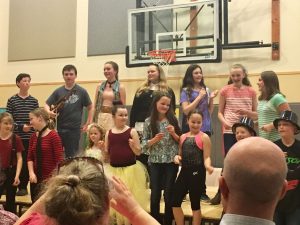
Ruth (Ramona) and Magnolia wrote and performed a charming, funny, and creative puppet show.
Rylee and Melia also performed a singing duet together, “I Wouldn’t Have Nothin’ if I Didn’t Have You”:
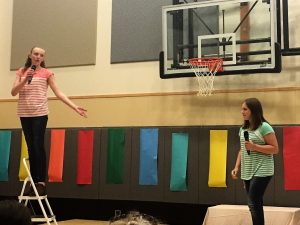

The girls sang and performed beautifully.
Special thanks to the PARADE PTSA and to Laura Mills, Carol Gould and Marcy Candland for organizing a fabulous show!
La primera semana del última trimestre / 1st week of the last quarter
¿Que hicimos esta semana? What did we do this week?
–Revisión de los conceptos / review of concepts so far
–tener / using the verb “to have”
– Los días de las semana / the days of the week
lunes, martes, miércoles, jueves, viernes, sábado, domingo (Monday through Sunday). Notice the Spanish days of the week are not capitalized.
–¿Por qué? Porque… / Why? Because…
Learning Targets
I can ask “how old are you?” and reply with how old I am.
I can name the days of the week.
I can correctly use the Spanish phrases for “why” and “because”.
Para el próximo martes, 25 de abril/ For Tuesday, April 25:
Complete “Lección 7: Los dias de la semana (The days of the week)” for homework, due April 25:


